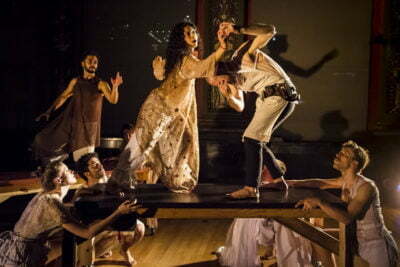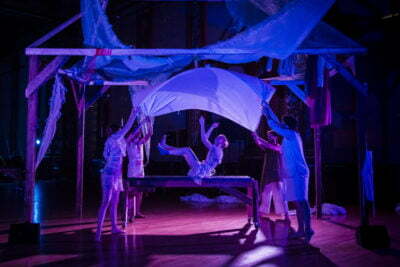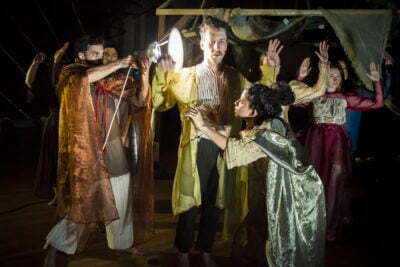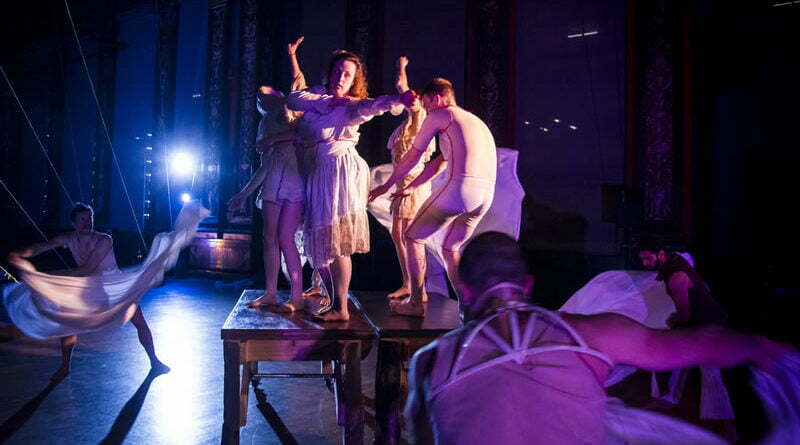The Cure
Directed by Kendra Miller
Movement Direction by Thom Pasculli
Created by Walkabout Theater Company
Produced in Association with DCASE
Old Library Makes Existential Struggle a Spectacle
If you’ve ever seen The Seagull, and wondered what Konstantin’s decadent dramatic experiment on the subject of matter and energy would look like as a complete production, Walkabout’s The Cure may be about as close as you’re going to get. Part promenade and part performance art, this meditation on death, medicine, and spirituality, with a commissioned text by Emma Stanton, is a dizzying display of symbols and archetypes whose meaning is highly subjective. But though the work is confusing and often frustrating, it is an interesting use of the Chicago Cultural Center’s strange architecture, and contains athletic, daring choreography by Thom Pasculli.
 Walkabout specializes in site-specific performances, and for their partnership with the Chicago Department of Cultural Affairs and Special Events, they were granted access to the downtown building that used to be the main library, and is located just across the street from Millennium Park. On the way to the Sidney R. Yates Gallery, audiences may observe the rope bridge staircases in the building’s courtyard, and the grand old decorations along the high ceiling. A feeling of history and mystery is established before the show proper begins, although Walkabout is doubtlessly aware of the feelings a nearly-empty grand old building evokes. Upon admission, we see, in text, the story of a woman with a terminal illness who sought relief through natural, and then, occult means. The performers enter the hallway slowly, but upon our admission to the main room, they break into wild acrobatics which include vaulting over moving furniture and dodging around rigging.
Walkabout specializes in site-specific performances, and for their partnership with the Chicago Department of Cultural Affairs and Special Events, they were granted access to the downtown building that used to be the main library, and is located just across the street from Millennium Park. On the way to the Sidney R. Yates Gallery, audiences may observe the rope bridge staircases in the building’s courtyard, and the grand old decorations along the high ceiling. A feeling of history and mystery is established before the show proper begins, although Walkabout is doubtlessly aware of the feelings a nearly-empty grand old building evokes. Upon admission, we see, in text, the story of a woman with a terminal illness who sought relief through natural, and then, occult means. The performers enter the hallway slowly, but upon our admission to the main room, they break into wild acrobatics which include vaulting over moving furniture and dodging around rigging.
 The story, such as it is, is a variation on the Orpheus and Eurydice myth, with con-artists, spirits, a professor of nineteenth century pseudo-scientific mysticism, and other families thrown in. The specifics of the stilted dialogue were usually difficult to make out once we were in the gallery, but the spectacle was enjoyable. About half-way through the show, Wallkabout abandons the promenade-style presentation, and simply seats us in a seating bank on the far side of the room, so we may watch a series of scenes which take place inside a pavilion with white sheets for walls. Some of them effectively communicated the struggles of grief, wasting, and fear of mortality through devices such as an actor struggling to free himself from a sheet his cast mates brought down upon him with increasing rapidity. The scenes in which the actors, who many of whom did not possess strong vocal power or diction, attempted to speak to the cavernous room were generally less successful.
The story, such as it is, is a variation on the Orpheus and Eurydice myth, with con-artists, spirits, a professor of nineteenth century pseudo-scientific mysticism, and other families thrown in. The specifics of the stilted dialogue were usually difficult to make out once we were in the gallery, but the spectacle was enjoyable. About half-way through the show, Wallkabout abandons the promenade-style presentation, and simply seats us in a seating bank on the far side of the room, so we may watch a series of scenes which take place inside a pavilion with white sheets for walls. Some of them effectively communicated the struggles of grief, wasting, and fear of mortality through devices such as an actor struggling to free himself from a sheet his cast mates brought down upon him with increasing rapidity. The scenes in which the actors, who many of whom did not possess strong vocal power or diction, attempted to speak to the cavernous room were generally less successful.
 Movement and design are Walkabout’s strengths, so they would do well to focus more on these elements as the work continues to evolve throughout its run. Those who enjoy performance art have little to risk by giving The Cure a chance. It’s free, only an hour long, in an amazing building, and is performed just as the sun’s setting and the skyscraper lights coming on can be seen through the massive windows. Those who are inclined not to like the genre will probably find little here, but death being such a personal thing, may find some catharsis in the show’s funerary moments.
Movement and design are Walkabout’s strengths, so they would do well to focus more on these elements as the work continues to evolve throughout its run. Those who enjoy performance art have little to risk by giving The Cure a chance. It’s free, only an hour long, in an amazing building, and is performed just as the sun’s setting and the skyscraper lights coming on can be seen through the massive windows. Those who are inclined not to like the genre will probably find little here, but death being such a personal thing, may find some catharsis in the show’s funerary moments.
Recommended
Jacob Davis
Reviewed June 3, 2016
Playing in the Chicago Cultural Center’s Sidney R. Yates Gallery, 78 E Washington St, Chicago. Performances are free to the public, visit walkabouttheater.org for advance reservations. Performances are Mondays, Fridays, and Saturdays at 8:00 pm through June 18. Running time is seventy minutes.

